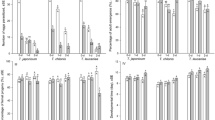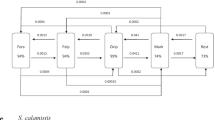Abstract
Through use of a recognition kairomone, the parasitoidTelenomus heliothidis Ashmead is induced to oviposit and successfully develops in nonhost eggs.T. heliothidis successfully develops in the eggs ofSpodoptera frugiperda (Smith) andPhthorimaea operculella Zeller, but fails to develop in eggs ofAnthonomus grandis Boheman. Both sexes of the parasitoid are produced from the nonhosts, and development time is the same as in a natural host such asHeliothis virescens F. The use of recognition kairomones could be of great use in artificial rearing of nongeneralist parasitoids suchT. heliothidis.
Résumé
L'emploi d'une kairomone de reconnaissance permet d'induire la ponte et d'obtenir éventuellement le développement deTelenomus heliothidis Ashmead dans des œufs d'espèces ne constituant pas de hôtes normaux de ce parasitoïde. Ainsi, à partir des œufs deSpodoptera frugiperda (Smith) ou dePhtorimaea operculella Zeller, la production de descendants adultes des 2 sexes deT. heliothidis est assurée dans un délai identique à celui constaté avec l'hôte naturelHeliothis virescens F. La ponte a également lieu dans les œufs d'Anthonomus grandis Boheman, mais le développement ultérieur échoue. L'utilisation de kairomones de reconnaissance peut être d'un grand intérêt pour l'élevage de parasitoïdes spécifiques telT. heliothidis.
Similar content being viewed by others
References
Arthur, A.P. — 1981. Host acceptance by parasitoids. In: Semiochemicals: Their Role in Pest Control (D.A. Nordlund, R.L. Jones &W.J. Lewis, eds.). —John Wiley, New York, 97–120.
Arthur, A.P. &Wylie, H.G. — 1959. Effects of host size on sex ratio, development time, and size ofPimpla turionellae L. —Entomophaga, 4, 297–301.
Hegdekar, B.M. &Arthur, A.P. — 1973. Host hemolymph chemicals that induce oviposition in the parasiteItoplectis conquisitor [Hymenoptera: Ichneumonidae]. —Can. Entomol., 105, 787–793.
Hoffman, J.D., Ignoffo, C.M. &Dickerson, W.A. — 1975.In vitro rearing of the endoparasitic wasp,Trichogramma pretiosum. —Ann. Entomol. Soc. Am., 68, 335–336.
Jowyk, E.A. &Smilowitz, Z. — 1978. A comparison of growth and developmental rates of the parasiteHyposoter exiquae reared from two instars of its hostTrichoplusia ni. —Ann. Entomol. Soc. Am., 71, 467–472.
Liu, W.H., Xie Xiao, Z.W., Zhaw, G.F., Ou Yang, D.H. &Li-Ying, L.I. —1979. Rearing of theTrichogramma dendrolimi in artificial diets. —Acta. Phyto. Sinica, 6, 17–24.
Miles, L.R. &King, E.G. — 1975. Development of the tachinid parasite,Lixophaga diatraeae on various developmental stages of the sugarcane borer in the laboratory. —Environ. Entomol., 4, 811–814.
Morrison, R.K. — 1970. A simple cage for maintaining parasites. —Ann. Entomol. Soc. Am., 63, 625–626.
Salt, G. — 1935. Experimental studies in insect parasitism. III. Host selection. —Proc. R. Entomol. Soc. Lond., 117, 413–453.
— — 1975. The fate of an internal parasitoid,Nemeritis canescens, in a variety of insects. —Trans. R. Entomol. Soc. Lond., 127, 141–161.
Simmonds, F.J. — 1944. The propagation of insect parasites on unnatural hosts. —Bull. Entomol. Res., 35, 219–226.
Strand, M.R. &Vinson, S.B. — 1983. Host acceptance behavior ofTelenomus heliothidis [Hymenoptera: Scelionidae] towardHeliothis virescens [Lepidoptera: Noctuidae]. —Ann. Entomol. Soc. Am., 76, 781–785.
Strand, M.R. &Vinson, S.B. — 1982. Source and characterization of an egg recognition kairomone ofTelenomus heliothidis, a parasitoid ofHeliothis virescens. —Physiol. Entomol., 7, 83–90.
Vanderzant, E.S., Richardson, C.D. &Fort, S.W., Jr. — 1962. Rearing of the bollworm on artificial diet. —J. Econ. Entomol., 55, 170.
Vinson, S.B. — 1976. Host selection by insect parasitoids. —Annu. Rev. Entomol., 21, 109–133.
Vinson, S.B. &Iwantsch, G.F. — 1980. Host suitability for insect parasitoids. —Annu. Rev. Entomol., 25, 397–419.
Author information
Authors and Affiliations
Rights and permissions
About this article
Cite this article
Strand, M.R., Vinson, S.B. Stimulation of oviposition and successful rearing ofTelenomus heliothidis [Hym.: Scelionidae] on nonhosts by use of a host-recognition kairomone. Entomophaga 27, 365–370 (1982). https://doi.org/10.1007/BF02372058
Issue Date:
DOI: https://doi.org/10.1007/BF02372058




